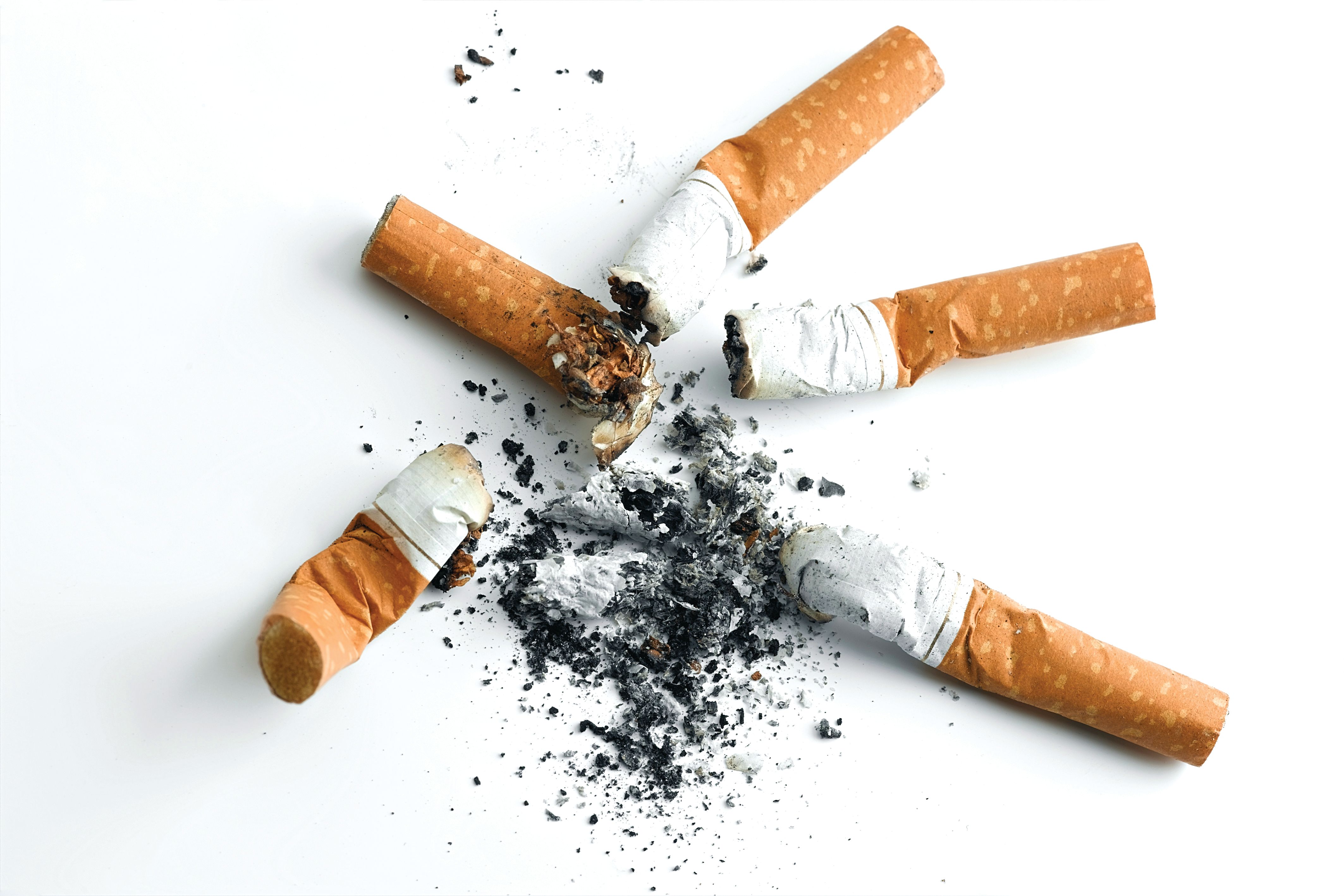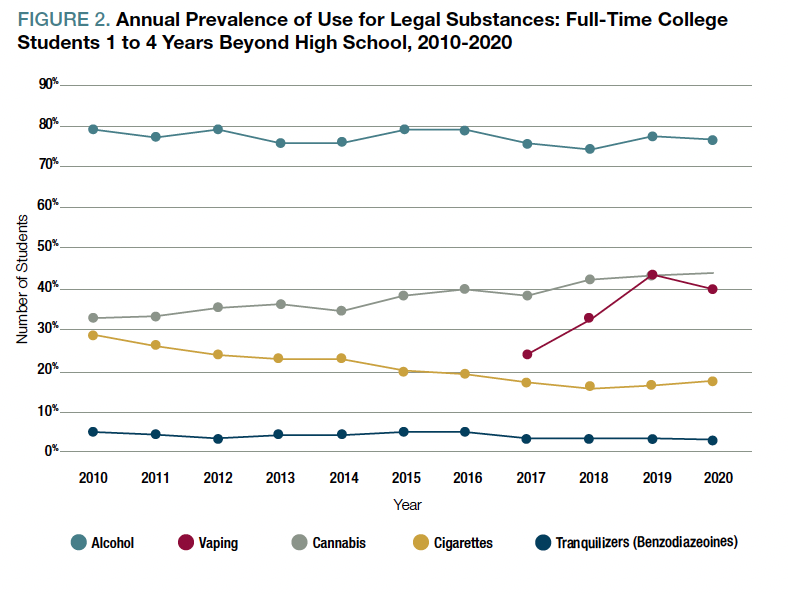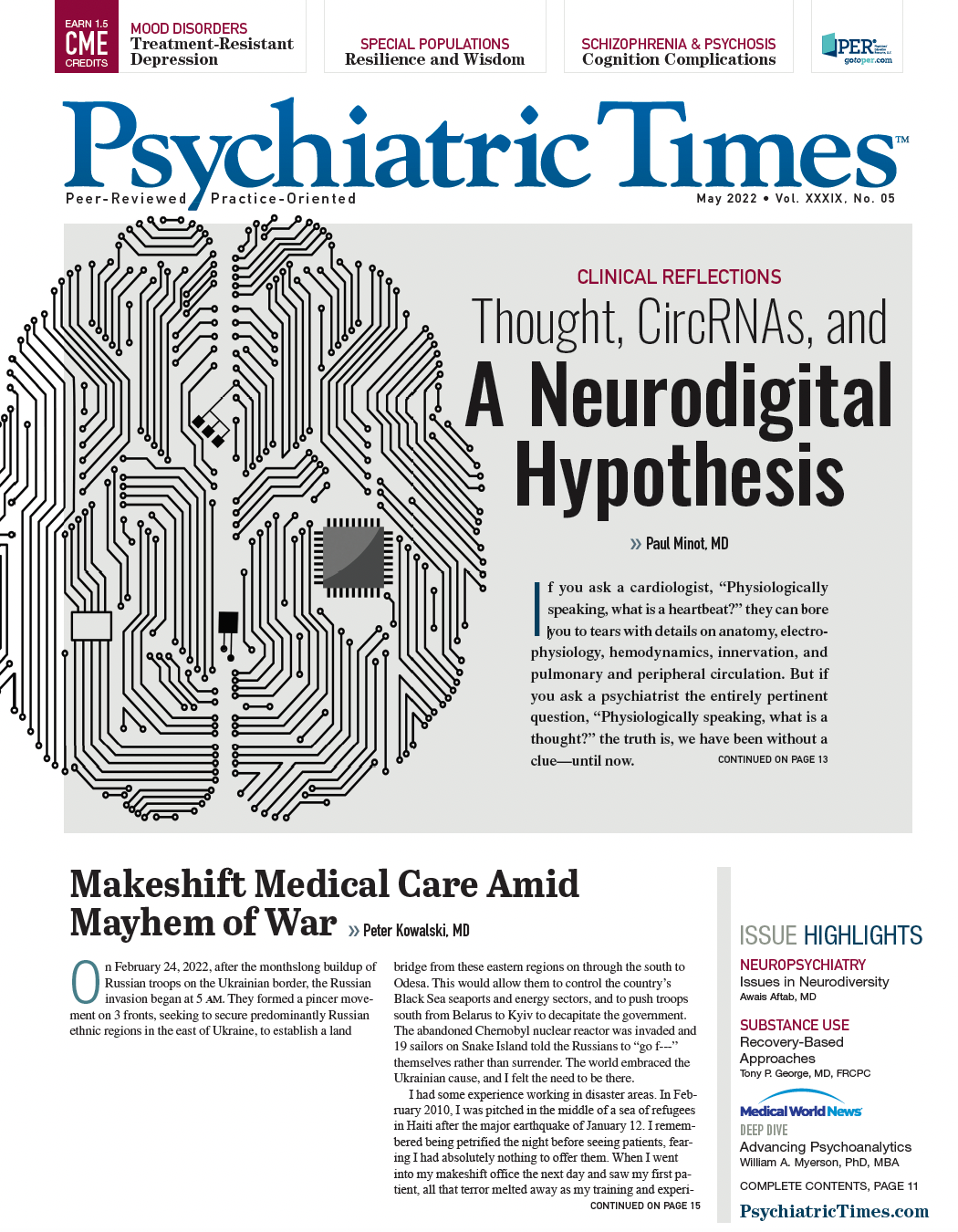SPECIAL REPORT: SUBSTANCE USE
Special Report Chairperson: Tony P. George, MD, FRCPC
Substance misuse has become increasingly common in the 21st century, especially among students enrolled in colleges and universities. It has social, economic, psychological, and physiological consequences among adolescents, especially with the emergence of the COVID-19 pandemic and its societal complications. The most used substances on college campuses include alcohol, cannabis, cocaine, prescription opioids, recreational drugs (eg, MDMA), and nicotine, and, more recently, e-cigarettes (vaping). Behavioral addictions (eg, internet gambling) are also very common.
Not only have substance use trends increased in the past 2 decades among university students, but negative perceptions and societal attitudes toward the use of illicit substances have also lessened. The adolescent brain is in a unique period of development at this age, leaving students at a heightened susceptibility to abnormalities on measures of brain functioning, including neurocognition1 and impulsivity,2 which are risk factors for the initiation and maintenance of substance use disorders.
Overall Patterns of Substance Use
Substance misuse is a strong predictor of student well-being, as it is associated with worsened mental health outcomes, poorer grades, and chronic health problems. According to the National Survey on Drug Use and Health (NSDUH), of the students aged 18 to 22 years, 5.9 million young adults smoked cigarettes in the past month (26.7%), 12.0 million drank alcohol (54.8%), almost 7.8 million engaged in binge drinking (35.3%),3 more than 4.5 million young adults used cannabis (20.7%) and 299,000 used cocaine (1.4%).3
Also In This Special Report
Recovery-Based Approaches and Forward-Thinking Policy: Implications for Addiction Care
Tony P. George, MD, FRCPC
Nonabstinent Recovery From Alcohol Use Disorder
Cassandra L. Boness, PhD; Alena Kuhlemeier, PhD; Katie Witkiewitz, PhD
Cannabis Legalization: What Psychiatrists Need to Know
Samantha Johnstone, BA; Kevin P. Hill, MD, MHS; and Tony P. George, MD, FRCPC
Dual Diagnosis: Double the Stigma, Double the Trouble
Darby J.E. Lowe, MSc; Emily Simpkin, RN; Tony P. George, MD, FRCPC
Substance use trends for alcohol use, binge drinking, and cocaine use in the past month were higher in full-time college students aged 18 to 22 years compared with their counterparts who were not enrolled in college.3 Between 2007 and 2014, the percentage of students who used cannabis daily nearly doubled.4 Recent results from the NSDUH published in 2020 have reported that cannabis use has continuously increased over the past 5 years in college students, reaching the highest level in more than 3 and a half decades in 2020 at 44%.5
E-Cigarettes and Tobacco Consumption
Trends in lifetime vaping rose from 26% of college students to 36% between 2015 and 2017. In 2020, the increase in vaping had leveled off, with only a 1% increase in lifetime users from 2019.5 E-cigarettes have become increasingly popular among university students for multiple reasons, including accessibility, a perception of low risk, and the appeal of e-cigarette flavoring in comparison to other smoking methods.6,7 As with the consumption of tobacco products, there are negative health effects associated with e-cigarettes. The use of nicotine during development increases the risk of long-term addiction and long-lasting consequences toward cognitive development.7
In another cluster sample by Primack et al, 114,245 individuals from 158 institutions were sampled from the 2008 to 2009 National College Health Assessment conducted by the American College Health Association to evaluate smoking behaviors.8 There were 6 clusters gathered, and smoking trends in the past 30 days were evaluated. These clusters included individuals who abstain from all substances (54%); individuals who use hookah but dislike cigars (5.5%); users of marijuana who will smoke cigarettes and drink (9.3%); frequent users of cigarettes with some alcohol use (6.9%); frequent consumers of alcohol with no smoking behaviors (17.1%); and cigar users in combination with other substances (7.3%).8 These results showcased the changes in trends over the past 10 to 15 years, with a rise in the use of tobacco and nicotine products. There is also concern from this study about combining various substances, a common practice among university students.
Alcohol
Alcohol is widely available through North America with the legal drinking age 21 in the United States and 19 in Canada. Not only is the perceived risk of alcohol consumption lowest in individuals aged 19 to 22 years as of 2020, but the prevalence of annual consumption is also highest in full-time college students 1 to 4 years after high school.5 High-risk populations that are more prone to alcohol consumption include fraternity and sorority members and students who used alcohol heavily in high school.9 As mentioned, alcohol is the most used substance among NSDUH survey respondents, with 54.8% of participants reporting use in the past month.3
Alcohol consumption has many impacts on the body, contributing to more than 200 diseases and injury-related health conditions, both acute and chronic.10 Of the most prevalent, alcohol use disorder, liver cirrhosis, cancers, and physical injuries are included. Other notable effects can be observed on a student’s mental health, as alcohol misuse may be associated with an increase in depressive symptoms, attempted suicide and self-harm behaviors, and aggression.10
Alcohol misuse, like any other substance misuse, is a public health concern. Because of the wide range of effects on physical, psychosocial, and mental health outcomes, monitoring alcohol use trends is essential as current use continues to increase. In 2020, both annual alcohol use (77% versus 67%) and 30-day use (56% versus 49%) were higher among college students than noncollege students.5 More alarmingly, the prevalence of binge drinking, which is defined as having 10 or more drinks in a row, was 12% for both college and noncollege respondents.5 It seems as though the drug epidemic that arose in the early 2000s paralleled a decreased perception of risk for alcohol, as well as increased consumption trends for individuals aged 18 to 22 years.5
Cannabis Use
Cannabis use reached an all-time high in 2020.5 Recreational cannabis is legal in 18 states, the District of Columbia, and Guam, as well as Canada. University students are at an age when they are at a higher predisposition to behavioral effects with frequent cannabis use.11 The regular use of cannabis during adolescence places individuals at a higher risk of developing cannabis use disorder (CUD).11 Frequent use of cannabis has also been associated with compromised university performance, including lower grade point average, delayed high school completion rates, and truancy.11
The perceived risk of cannabis has also significantly decreased in the last decade with all individuals between ages 18 and 30 years having the lowest recorded perception of risk for occasional marijuana use in the last 30 years.5 The annual prevalence of cannabis use is slightly higher in full-time college students compared with noncollege students in the first 4 years after high school; however, both groups report that more than 40% of individuals have used cannabis in the past year.5 On most indices of cannabis use including 30-day use and daily use, use by men was significantly higher than by women.5 CUD risk factors include living alone, recent negative life experiences, and using cannabis as a means of coping.11
The use of cannabis during brain development can have profound effects on cognitive performance after just 4 weeks of regular cannabis consumption.1 The use of cannabis during adolescence has been associated with higher gray matter volumes in the brain, which was associated with poorer verbal and attentional performance.1
Cocaine and Stimulants
The use of cocaine and stimulants (eg, prescription stimulants and methamphetamine) poses great risk for university students. In 2016, it was noted that 4% of full-time college students used cocaine in the past year, 1.4% used cocaine in the past month, and 20% were exposed to opportunities for cocaine in the past year.9 In addition to cocaine, college students use other stimulants, including dextroamphetamine, a prescription stimulant for cognitive enhancement purposes.
Not only has the use of prescription stimulants increased, but so has the social acceptance around stimulants.9 The annual prevalence of mixed amphetamine salts (Adderall) compared with methylphenidate (Ritalin) for nonmedical use was much higher for Adderall, with 7.6% of individuals between 19 and 30 years old using it compared with 0.9% to 2.6% of 19- to 30-year-olds using Ritalin.5 In addition, the annual use of nonmedical amphetamines was higher among men than women (7.7% versus 5.8%), especially for Adderall (8.8% versus 6.9%).5 Comparing full-time college students to nonstudents, the percentage of cocaine use in the past month was 1.8% vs 1.1% according to the 2016 NSDUH.3 The use of stimulants becomes extremely dangerous in students when they are combined with other substances, specifically alcohol. The counteractive effects of sedative alcohol and stimulant use leads to serious effects on the central nervous system and poses an overall significant health risk.12
Benzodiazepines
Benzodiazepine use also poses a potential threat to college students. Benzodiazepine use has increased over the last few decades, especially for nonmedical purposes. In 2019, the use of benzodiazepines for nonmedical purposes in college and noncollege respondents was 3% and 3.4%, respectively.5 With this, the overall annual prevalence of benzodiazepine nonmedical use in 2019 among respondents aged 19 to 30 years was 3.7%.5 A common benzodiazepine used among the college demographic is Xanax (“Xans”), of which misuse has risen over the past decade.
The increased media attention on this drug from celebrities may increase the temptation for high school students to try it. Many students without anxiety or depression use it for the sedation and calm that accompany a high.5 Because of the addictive nature of the drug, this becomes an issue for college students who resort to benzodiazepines without a medical prescription to deal with overwhelming feelings of anxiety.13 Benzodiazepine misuse can lead to increased tolerance, which may prompt a user to take higher doses, which can then lead to habitual use, along with the risks of serious benzodiazepine withdrawal and seizures.13
Internet Addiction
While the internet is a useful tool for many college students, especially with social media and its pertinence to online classes throughout the COVID-19 pandemic, internet addiction can negatively impact the lives of college students in physical, social, and mental health aspects. While the internet facilitates research and interpersonal communication, it can also be used to indulge in pornography as well as excessive gaming or gambling and use of social media (eg, Twitter and Instagram).
Internet addiction can lead to personal, familial, financial, occupational, and academic problems, particularly in college students. Studies suggest that individuals with internet addiction have higher rates of psychiatric comorbidities, suicidal ideation, and suicide attempts compared with those without internet addiction.14 Although the internet has become an integral part of society over the last decade, excessive internet use should be monitored to prevent feelings of anxiety, depression, and social isolation.
Impact of COVID-19
The COVID-19 pandemic has had tremendous impacts on society, especially on college students. The disruptions in regular university life have led many students to suffer from impaired mental health and an increase in substance use.15 The COVID-19 outbreak has become temporarily associated with higher rates of anxiety, depression, stress, posttraumatic stress symptoms, and psychological distress in individuals aged 21 to 30 years.
A retrospective study of 4749 participants from 7 US universities or colleges found that university closures amid the pandemic resulted in a 13% and 24% increase of alcohol and cannabis use, respectively, after 30 days following the closure.15 Additionally, depressive symptoms and anger were modestly higher in postclosure participants compared with preclosure participants.14 Although the differences in pre- and postclosure outcomes are modest, which may show strong resilience in university students, university and college health care providers need to ensure they are providing appropriate resources to students who are experiencing significant increases in mental health symptoms and substance use.
Since the last national survey results on substance use were published in 2020, there have been few reports on substance use and mental health, which will be necessary to more comprehensively understand the impact of COVID-19 on substance use in this population. It has been observed throughout the pandemic that individuals have developed and relied on many maladaptive coping mechanisms; however, how university students have been able to cope is still to be determined.16
Concluding Thoughts
Overall, substance misuse poses a great risk for all individuals, especially those who are still in a critical period of development such as college students. Trends in illegal and legal substance use are shown in Figures 1 and 2, respectively. Substance use in university students can be influenced by many risk factors, such as low harm perceptions, peer influences, and coping with a difficult transition period. It is crucial for colleges and universities to assess the trends in substance use and provide resources to their students to avoid chronic substance use and related harms.
With the prevalence of substance use increasing over the past 5 years among full-time college students, preventive measures must be implemented to avoid increases in substance use prevalence. High school drug awareness programs can help students who plan to enroll in college mitigate risks of substance use upon enrollment. Additionally, the inclusion of first-year drug awareness programs can help prepare newly enrolled full-time college/university students for the academic stressors they will encounter in order to develop healthy coping mechanisms.
Ms Kivlichan is a senior undergraduate student at Queen’s University in Kingston, Ontario, Canada, and a research practicum student at the Centre for Addiction and Mental Health (CAMH), Toronto, Ontario. Ms Lowe is a recent graduate of the Institute of Medical Science of the University of Toronto and a consultant to the Centre for Complex Interventions (CCI) at CAMH. Dr George is professor of psychiatry in the Temerty Faculty of Medicine at the University of Toronto and clinician-scientist in the Addictions Division and the CCI at CAMH. George is on the editorial board of Psychiatric Times™ and incoming coprincipal editor of Neuropsychopharmacology (NPP).
References
1. Squeglia LM, Jacobus J, Tapert SF. The influence of substance use on adolescent brain development. Clin EEG Neurosci. 2009;40(1):31-38.
2. Kozak K, Lucatch AM, Lowe DJE, et al. The neurobiology of impulsivity and substance use disorders: implications for treatment. Ann N Y Acad Sci. 2019;1451(1):71-91.
3. Lipari R, Jean-Francois B. Trends in perception of risk and availability of substance use among full-time college students. In: The CBHSQ Report. Substance Abuse and Mental Health Services Administration (US); August 16, 2016:1-12.
4. Schulenberg JE, Johnston LD, O’Malley PM, Bachman, JG, Miech RA, Patrick ME. Monitoring the Future: National Survey Results on Drug Use, 1975-2017: Volume II, College Students and Adults Ages 19-55. National Institute of Drug Abuse. 2018.
5. Schulenberg JE, Johnston LD, O’Malley PM, et al. Monitoring the Future: National Survey Results on Drug Use, 1975-2017: Volume II, College Students and Adults Ages 19-55. National Institute of Drug Abuse. 2021.
6. Grant JE, Lust K, Fridberg DJ, King AC, Chamberlain SR. E-cigarette use (vaping) is associated with illicit drug use, mental health problems, and impulsivity in university students. Ann Clin Psychiatry. 2019;31(1):27-35.
7. Jones RD, Asare M, Lanning B. A retrospective cross-sectional study on the prevalence of e-cigarette use among college students. J Community Health. 2021;46(1):195-202.
8. Primack BA, Kim KH, Shensa A, et al. Tobacco, marijuana, and alcohol use in university students: a cluster analysis. J Am Coll Health. 2012;60(5):374-386.
9. Welsh JW, Shentu Y, Sarvey DB. Substance use among college students. Focus (Am Psychiatr Publ). 2019;17(2):117-127.
10. Mekonen T, Fekadu W, Chane T, Bitew S. Problematic alcohol use among university students. Front Psychiatry. 2017;8:86.
11. Mader J, Smith JM, Afzal AR, Szeto ACH, Winters KC. Correlates of lifetime cannabis use and cannabis use severity in a Canadian university sample. Addict Behav. 2019;98:106015.
12. Singh AK. Alcohol interaction with cocaine, methamphetamine, opioids, nicotine, cannabis, and γ-hydroxybutyric acid. Biomedicines. 2019;7(1):16.
13. Brett J, Murnion B. Management of benzodiazepine misuse and dependence. Aust Prescr. 2015;38(5):152-155.
14. Kumar M, Mondal A. A study on internet addiction and its relation to psychopathology and self-esteem among college students. Ind Psychiatry J. 2018;27(1):61-66.
15. Schepis TS, De Nadai AS, Bravo AJ, et al. Alcohol use, cannabis use, and psychopathology symptoms among college students before and after COVID-19. J Psychiatr Res. 2021;142:73-79.
16. Avena NM, Simkus J, Lewandowski A, et al. Substance use disorders and behavioral addictions during the COVID-19 pandemic and COVID-19-related restrictions. Front Psychiatry. 2021;12:653674. ❒










